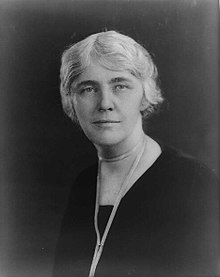Louise "Lou" Henry Hoover (March 29, 1874 - January 7, 1944) was the wife of Herbert Hoover, the President of the United States. As the wife of the president, she acted as the First Lady of the United States from 1929 to 1933.
Lou Henry Hoover | |
|---|---|
 A photograph of Lou Henry Hoover | |
| First Lady of the United States | |
| In role March 4, 1929 – March 4, 1933 | |
| President | Herbert Hoover |
| Preceded by | Grace Coolidge |
| Succeeded by | Eleanor Roosevelt |
| Personal details | |
| Born | Louise Henry Hoover March 29, 1874 Waterloo, Iowa, U.S. |
| Died | January 7, 1944 (aged 69) New York City, New York, U.S. |
| Occupation | First Lady of the United States |
| Signature | |
Early years
changeHer birthplace is Waterloo, Iowa. Her parents were Charles D. Henry and Florence. She spent her first ten years of her life at Iowa. Then, her father thought that the climate of southern California would be good for the health of Florence, his wife. The family came to live in Whittier, California. The place was later the childhood home of President Richard Nixon.
Her father, Charles Henry took her on camping trips. She became a very good horsewoman. She also hunted. She also developed interest for rocks, mineral, and mining.
She studied in two schools and got a certificate in teaching. Then she came to study at the Stanford University in 1894. She completed her course and became the first woman in Stanford's geology department. There she had met in a laboratory Herbert Hoover, her senior at the university.
Marriage & family
changeLou and Herbert Hoover married in 1899. Once Herbert Hoover said that her blue eyes and broad grins had attracted him.
The newlywed couple went to China where her husband became famous as a mining engineer. He also worked in many other countries and places of the world: for examples, in places in Ceylon, Burma, Siberia, Australia, Egypt, Japan, and Europe.
She had two sons: Herbert Charles Hoover (August 4, 1903 - July 9, 1969) and Allan Hoover (July 17, 1907 - November 4, 1993).
Her husband, Herbert Hoover earned a lot of fame after the First World War. He became famous for his good work in managing emergency relief programs. She lived with him, but sometimes spent time with her two sons in California. In 1919, the couple started constructing a house at Palo Alto, California. By this time, her husband became United States Secretary of Commerce. The couple lived in Washington for eight years. She did well socially as a wife of the Cabinet Secretary. She also took an active role in the Girl Scouts of the USA. She also served as the president of the Girl Scouts of the USA.
The First Lady
changeIn 1929, the Hoover couple came to live into the White House. Lou Henry Hoover had a long experience as wife of a famous man who had worked in the United States and in many foreign countries. She started her role as the First Lady. She was charming and dressed handsomely. She did it very well all through the term of her husband as the President. However, during this period, the Hoovers broke a tradition. On the New Year’s Day of 1933, they were away from the White House. Thus, they were not present to greet the public personally. Their absence ended the tradition of the President and the First Lady greeting the public on the New Year’s Day.
Retired life
changeIn 1933, the Hoovers couple retired to Palo Alto. But, they also kept an apartment in New York. Mrs. Hoover died on 7th January 1944 at the age of 69. She died of a heart attack. After her death, Mr. Hoover came to know of many gifts given by his wife. She had helped many boys and girls to get education. Mr. Hoover described her as: "a symbol of everything wholesome in American life."
Now, their house in Palo Alto is the official residence of the President of Stanford University. The house is one of the National Historic Landmarks. Lou Henry Hoover Elementary School in Whittier (built in 1938) bears her name in her honor. Her statue stands at the place where her childhood home was at Waterloo, Iowa.
References
changeOther websites
change- The Herbert Hoover Presidential Library-Museum Archived 2003-12-09 at the Wayback Machine